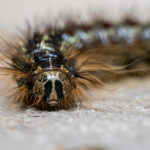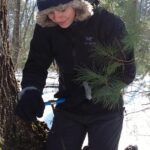Press Contact: Clarisse Hart, Harvard Forest Outreach Director
Hart3@fas.harvard.edu; 978-756-6157
Scientific Paper and Supporting Resources
- Read a blog post about the study, written by lead author Audrey Barker Plotkin.
- Download the full text of the paper in Functional Ecology: Defoliated trees die below a critical threshold of stored carbon
Press Release
For Trees, Carbs Are Key to Surviving Insect Defoliation
A recent multi-year outbreak of an invasive moth killed thousands of acres of oak trees across southern New England. But interspersed among the wreckage were thousands of trees that survived. A new study published today in Functional Ecology sheds light on why. Research by scientists from Harvard, UMass Amherst, Boston University, and MIT reveals that a tree’s carbohydrate reserves are crucial to surviving an onslaught of hungry caterpillars.
The biology of trees makes them resilient to even the most severe stressors. “Oak trees are planners, in a way,” says Meghan Blumstein, NSF Post-doctoral Research Fellow at MIT and a co-author of the study. “Some of the food they make during the growing season is used immediately for energy and some is stored in the stems and roots for a rainy day. With stored carbs, they are able to immediately create a new flush of leaves after an insect outbreak.”
But trees are not invincible, and the new study reveals the specific threshold of reserves necessary for them to survive: 1.5 percent carbohydrates in their dried wood– or about 20-25% of their normal storage capacity. The repeated emergence of Lymantria dispar (an insect formerly known as “gypsy moth”) from 2016 to 2018 challenged trees’ resilience by defoliating them year after year.
“The trees that died were the trees that were out of reserves,” says lead author Audrey Barker Plotkin, a Senior Scientist at the Harvard Forest. But the location of the trees mattered, too. The research team found that trees growing along forest edges tended to have more reserves, even at the same level of defoliation, making them more resilient than interior forest trees. The research team posits that forest edge trees may have simply experienced less severe defoliation in the years before 2018. And, because edge trees get lots of light, they may also be able to rebound without drawing down their reserves as much as their interior forest counterparts.
The new study provides direct evidence, that had until now been lacking, that trees can indeed starve to death when insects invade. This more nuanced understanding will help improve forest resilience models as new pests and a shifting climate continue to drive change in the region.
###
The Harvard Forest, founded in 1907 and located in Petersham, Mass., is Harvard University’s outdoor laboratory and classroom for ecology and conservation, and a Long-Term Ecological Research (LTER) site funded by the National Science Foundation. Its 4,000-acre property is one of the oldest and most intensively studied research forests in the U.S. More information can be found at http://harvardforest.fas.harvard.edu/.
Photos
(Click image to download high-res)
Lymantria dispar (caterpillar shown here) is one of the most destructive invasive insects in North America. Defoliation by this insect can kill oak trees by draining the trees’ energy reserves. Photo credit: Nathan Oalican.
Meghan Blumstein sampling carbon in tree roots in February 2019. Photo credit: Audrey Barker Plotkin.

